by Megan Atkinson
If celebrated, regions and cultures vary greatly when they celebrate Christmas, and these traditions also differ throughout history. The Upper Cumberland celebrated Christmas differently than some in Tennessee’s and the United States’ more prosperous and populous areas, due to local traditions, resources, transportation, or financial means. Early Christmas was unlike the Christmas holiday of the late 20th century in all parts of the United States, but the Upper Cumberland adapted these changing traditions to fit with the region’s unique set of circumstances. Christmas focused on community, small presents, and homemade decorations. With few or no radios or televisions, shopping centers, Christmas lights, Christmas catalogs, internet, and Christmas television specials, the Christmas season in the Upper Cumberland was much simpler than in the 21st century.

Christmas customs we are familiar with are mostly derived from Victorian times, but the idea of a Christmas celebration began long before. In the fourth century, the Catholic Church made a holiday from the birth of Jesus. Pope Julius I selected December 25 and the custom, called Feast of the Nativity, grew. Christmas celebrations did not follow the original settlers to America due to Puritan beliefs, but instead, they came into favor beginning in the 1800s. The 1800s saw the appearance of Washington Irving’s publications and actions promoting the holiday, Charles Dickens’s A Christmas Carol (1843), Clement Clark Moore’s T’was the Night Before Christmas (1822), and Thomas Nast’s Santa lithograph in Harper’s Weekly (1862) – all which influenced modern Christmas traditions, including Santa, stockings, and gift giving. Santa Claus began public appearances around the 1890s. Although a long tradition in some cultures, the Christmas tree only gained wide acceptance after an illustration circulated in 1846’s Illustrated London News depicting Queen Victoria and Prince Albert with the royal family around a Christmas tree. The trend moved to the Eastern United States and with it came ornaments from German immigrants, who celebrated the tradition as early as the 1830s. Christmas was declared a federal holiday in the United States until 1870. Many people in the Upper Cumberland, due to their remoteness and income, did not participate in some modern holiday traditions until later. Still, they created traditions that were unique to the region.
Without television and few radios, newspapers took the forefront in spreading news and information regarding the Christmas holiday. Gift-giving began in the early 19th century and papers in the Upper Cumberland began advertising business’s holiday wares. Local newspapers, such as the Putnam County Herald, ran ads for gifts including a “box of fine chocolate” from Hickey Grocery Company, photographs from Harding Studio, and silverware and jewelry from Jere Whitson Hardware or Borden’s. Much like television programming features Christmas programming throughout the season in the 21st century, newspapers such as the Putnam County Herald published Christmas stories throughout the holiday. Authors and poets such as Clara Cox Epperson contributed stories of Christmas and the paper ran Christmas-related content from local and national publications, including songs, sermons, parables, poems, and stories about the origins of Christmas. The local newspaper was a major source of information and entertainment regarding the Christmas holiday in 19th and early 20th century Cookeville.
The local newspapers’ “society pages” acted as a Facebook “check-in” and an events page, allowing people to promote various social and cultural events in the area but also allowing for gossip. Announcements appeared in the Putnam County Herald such as “There will be entertainment and also a Christmas tree at Free Union, Dec. 24 Everybody invited -Santa,” “Miss Marie White is here to spend the holidays with her family,” and “Buck Ligon and family are spending Christmas with friends in Double Springs.” Announcements for events, gatherings, and visitation would come from across the Upper Cumberland including Hilham, Pleasant Hill, Monterey, Gainesboro, and Mayland, and were published for all readers of the newspaper. The society pages allowed the community to learn about neighbors and events.
Early records indicated that much of what happened during Christmas in the Upper Cumberland in the 19th and early 20th century included visiting and gathering with friends and families and dancing, playing music (including fiddle playing), and singing—sometimes until the late hours. Parties were especially popular for the young. Locals tell of dancing by candlelight and oil lamps each night of the week starting at dark. Some sang around the fire from gospel songbooks. In Algood in 1919, “The young folks had a real nice time at the singing given by Harry and Molly Stamps Christmas Night, in Three Springs,” and “Peyton Phy gave the young folks a singing Saturday night.” By one local account, these dances were referred to as “breakdowns.” These events took place throughout the season and brought together – in celebration of the holiday – friends, family, and the community.
During times of conflict, celebrating the Christmas holiday was often done with war looming in the background of most traditions. During the Civil War, parties were mostly women. A Confederate soldier named Thomas R. Hooper described a party with 25-30 ladies on Christmas night, with only a few soldiers and men. Some soldiers fought during the Civil War while others were furloughed at Christmas. Some families even played host to regiments. During World War I, many children wrote to Santa, and letters were published in the paper. These letters asked for help from the soldiers instead of gifts. Mina Opal Jared asked for only fruit and candy, but to “help the Soldier Boys” instead of her in 1918. Newspaper pages included questions such as “How can the world sing with joy…this Christmas time when there is so much horror?”
Spirits were not unusual in an Upper Cumberland Christmas celebration but appeared more common in the 19th century. In a description by Mrs. J. H. Carlen regarding Christmas in late 19th century Cookeville, all five saloons on Cookeville’s square were bustling. Many purchased spirits for the holiday, such as William B. Stokes of Smith Fork who bought two gallons of French Brandy for Christmas. In Smith Fork, James Tubb Jr. was reported to have sold three times the normal amount of liquor during Christmas (1816). Locals also complained of boys hitting the “mountain dew” for Christmas a little early in the season. The consumption of spirits changed after prohibition.
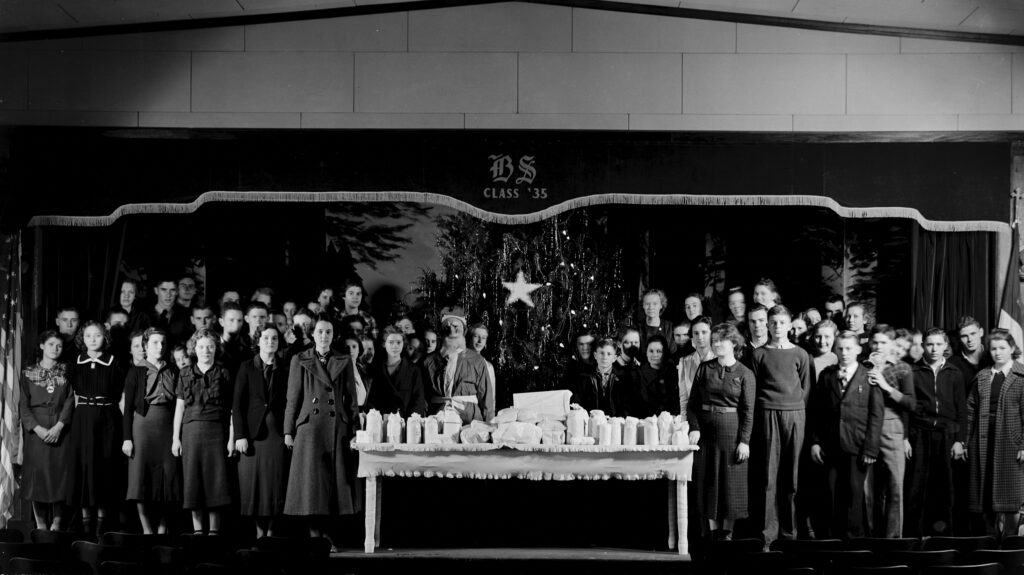
Many local churches, communities, and schools offered Christmas programs including songs, service, dinner, and sometimes even presents. Some churches distributed presents and families brought baskets to pack goods for home. Shipley United Methodist Church in Cookeville hosted Christmas Day with service, Sunday School, addresses, presents, and dinners in 1911. The annual Christmas program at the Cookeville Methodist Church on Cookeville’s square drew in over 200 people from the town and countryside and was declared the biggest celebration of the year in late 19th century Cookeville. One year it was so big it caused the church’s foundation to crack and settle. Poplar Grove had a community Christmas tree “trimmed in various colored confetti and tiny candles” and provided “gifts for all” in 1913. In Jackson County, the Woodrow School planned entertainment and a Christmas tree, and in Brotherton, Putnam County, the Christmas program was at the school; it had entertainment, a Christmas tree, several presents, speaking, and singing in 1917.
While there were fewer enslavers in the Upper Cumberland than in some of the South, slavery was in practice in the area. For instance, the White Plains home during the mid-19th century had approximately 100 enslaved people. Some enslavers would give gifts including goods, clothing, and shoes, usually from materials produced by enslaved people. The enslaved themselves could be gifts, as in the case of Louis Hughes, who wrote about being a gift for a purchaser’s wife for Christmas Eve in his autobiography Thirty Years a Slave. Some enslavers gave enslaved people time off for Christmas. Time off during the holidays was a tradition that Southern plantation owners followed, and it was derived from older European and colonial customs. When time off was given during the holiday, it was not necessarily from the kindness of the enslavers’ hearts, but rather from tradition and to prevent uprisings and hope of having the enslaved people conform to the European ideal of culture and religion. For instance, James Tubb of Smithville, the distiller, had 25 enslaved people and he allowed them time with their families. Many enslavers would “rent” enslaved people for the year and these contracts would be completed by the end of the year, meaning many returned to enslavers at Christmas.
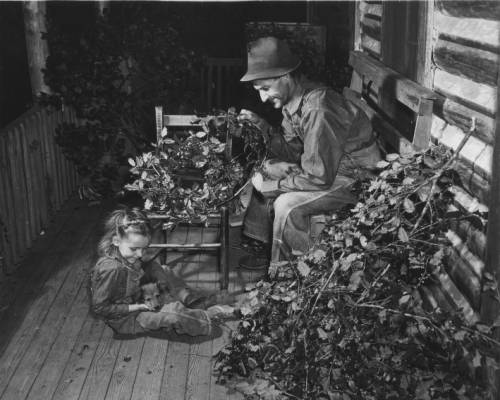
Christmas trees appeared in the southern United States after the Civil War. According to historian William Lynwood Montell, Christmas trees were in most living rooms by the 1920s, but uncommon before that. Before Christmas trees made it into living rooms, the Upper Cumberland had community Christmas trees, many offered by local churches and communities. Smithville’s first Christmas tree was in 1875 at the Smithville Methodist Church. Katy Lorena Angel Emery remembered going to see community Christmas trees at Ravens Croft and Glade Creek Church in the early 20th century. There was also a community tree in Union Grove in 1913. Popular Christmas trees were spruce and fir, but in the Upper Cumberland, the Eastern red cedar was popular due to its size, shape, aroma, and distribution. Trees were decorated with popcorn, paper ornaments, and paper chains. Other decorations include magnolia leaves, pinecones, natural berries, and evergreen branches on the mantle. Katy Lorena Angel Emery also remembered picking mistletoe and holly with red berries to decorate and for stringing night, where she was taunted by the fresh popcorn they were stringing for the tree.
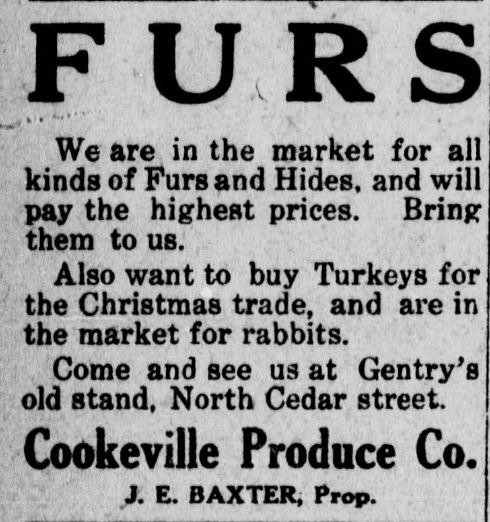
Limited on Christmas fixings due to a lack of supermarkets and transportation infrastructures, produce and food goods were more limited in types, although many stores got in delicacies for the season. For dinner, a traditional meal included deer or turkey that was hunted prior. At the turn of the 20th century, chicken replaced wild turkey for a short while due to wild game scarcity from hunting and habitat destruction. In 1917, Cookeville Produce Company sought turkeys from hunters for Christmas and would pay the “highest price.” Turkey appeared again after commercialization of the meat (early 1900s). Sorghum molasses was popular and readily available in the Upper Cumberland (1850). It was baked into gingerbread and cookies. Sorghum, imported from Africa in 1857, was grown locally instead of sugar due to its shorter growing season and price. Other accounts of Christmas feasts include opening canned goods from the summer and uncovering apples holed up for the winter in pits or apple houses. According to newspaper ads, specialty food items for sale on Christmas in various Upper Cumberland stores included oysters, prunes, dates, citrons, currants, mince meats, pickles, nuts, pepper sauce, jellies, raisins, and sardines.
Around the turn of the 20th century, gift-giving became more common throughout the United States. Stores would advertise numerous toys and sweets. Most children in the Upper Cumberland did not receive a substantial number of gifts – if any – until the 1940s, according to Lynwood Montell, though stockings were in the Upper Cumberland by the 1860s. According to Emily Spivack writing for Smithsonian Magazine, stockings were a custom derived in approximately 1823 with the publication of “The Night Before Christmas (Account of a Visit from St. Nicholas)” by Clement Clark Moore which read that Santa “fill’d all the stockings; then turn’d with a jerk.” Early gifts included marbles, riding stick horses, bladders of butchered hogs that were popped for noise, and shoes in lye soap for sledding.
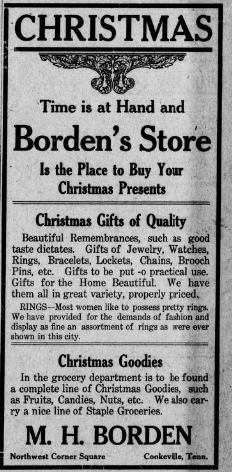
The children asked for a few toys and candies. A small toy, called by some locally a “grimcrack,” was often put in the stockings or gifted. Boys may get knives, and girls may get dolls and doll accessories, including the sleeping doll with eyes that closed, which was developed in the late 19th century. Candies and confectionaries were popular including peppermint sticks, twisted candy, and jawbreakers. Sugar was expensive and a regular diet of candy every day was uncommon due to cost and availability. Children did not ask for many gifts in the early 20th century. Ovanlie Myers only asked for “lots of candy and oranges” for Christmas and Evelyn Blank asked for “a nice new doll, candy, oranges, apples, and bananas.” These requests for presents from Santa were often published in the local newspaper. At the beginning of the 20th century, advertising for Christmas wares began in early November in the Putnam County Herald. Wares such as bicycles, toilet sets, books, toy stoves, balls, and pistols were advertised by Phillips and Buttorff Manufacturing in Nashville. Finer gifts, such as silverware and tableware, were advertised by M. H. Borden. Gift-giving gradually expanded by the late 20th century and became more common as the holiday traditions expanded, due to Christmas retail marketing strategies and promotion increasing the commercial empire that Christmas is in the 21st century.
For Christmas, many children asked for and received oranges because they were special despite their common appearance in the grocery store today. When the railroad came to Tennessee, Upper Cumberland residents could take shopping trains to Nashville on the Tennessee Central Railway but also receive goods from other states, such as Florida. With the availability to move items easier, children received more exotic items such as oranges and stalks of banana, and later at the turn of the century, there are even accounts of coconuts. Oranges were extremely popular and considered rare and expensive. The orange was popularized in the 19th Century with hanging stockings. It was the most popular memory and present according to many accounts. On Christmas day in 1849, the White Plains general store in Algood, Tenn. made 25 sales, mostly including sugar and coffee. One sale to Stephen Decatur Burton included three dozen oranges at $2.90. In 1920, Willie T. Scott asked Santa for “all the candy, nuts, apples, and oranges you can carry.” A letter published on December 19, 1912, from Umatilla, Florida to the Putnam County Herald shared that “Orange picking and packing is the order of the day…” and that, “Twelve carloads left here this morning, so look out for Christmas.” Transportation infrastructure increased the availability of goods for the holidays in the Upper Cumberland.

Fireworks and firecrackers of all sizes were incredibly popular in the whole South at Christmas time, including Roman candles, sparklers, skyrockets, split devils, and torpedoes (circa 1900). Many accounts in Southern history could not separate fireworks as part of the Christmas holiday, more so than the Fourth of July. Firecrackers might seem like an odd present for children, but this request appeared as early as the Victorian era. In McMinnville in 1890, the Southern Standard reports that “The small boy’s stock of fireworks…played out early on Christmas eve. Our streets were as quiet as usual by nine o’clock.” According to A. L. Stone, “Christmas was observed here [in Baxter] in the usual [sic] style, exploding fireworks, Christmas tree, and Santa Claus” (1911). Walter Hays Greenwood specifically asked for “some sparklers and some soldiers that stand up” for his Christmas gift (1921). Some announcements in the paper regarding fireworks were a little more ominous including this message from an unnamed Putnam County expat to Taylor Dunavan asking “…have you forgot last Christmas day? Is old Red afraid of firecrackers now?” If fireworks were not available, firearms could be discharged, leaving some to claim that the South had “the loudest Christmas in the world.” Creatures were stirring at Christmas in the Upper Cumberland.
The Christmas holiday also brought the community together to help those in need through charitable works. In 1918, the First Presbyterian Church offered a Christmas program with gift packages to be brought to everyone — “anything that would help any poor woman or child have a happy Christmas.” Gainesboro Telephone Company held “bundle day” to hang stockings for the collection of goods for needy children. On November 23, 1916, United Charities hosted a Charity Bundle Day and the boxes delivered filled with clothing and provisions. In 1916, the Ladies Aid Society gave away presents and food baskets to children whose parents could not afford them. Numerous groups and churches came together to ensure children and families had a proper holiday – so much so that in the Putnam County Herald on December 13, 1917, one citizen complained that there were, “too many charities, too many begging committees, too many different ways of getting glory by spending other People’s money.” Fortunately for some children, it appears from the newspaper that more people were participating in the charities than there were cynics.
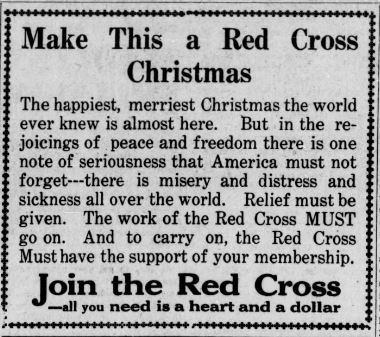
One event that happened at Christmas that is much less common now, is the act of getting married at Christmas. This was an earlier Victorian tradition from the 18th and 19th centuries that the Upper Cumberland participated in until the early 20th Century for the same reasons. Many people worked six days a week with one day off and possibly December 25 and 26 would be days that most people had off. There were no paid vacation days, making the holiday the best time to convene for a marriage celebration, and the service cost less on Christmas day. Mitchell Jackson and Jennie Young married on Christmas in 1913, Dr. H. E. Sidwell and Hettie Windle of Celina, John Nash and Ova Chaffin, and Hiram Lee and Almeda Thomas were all married on Christmas in 1912. In 1919, Fanalue Whitson and William Benton Carlen married on Christmas Eve at 9:30 pm. Before the 20th century, enslaved people, when they did receive time off for the holidays, also took advantage of the Christmas season to marry. Weddings before the late 20th century were mostly simpler affairs and less expensive.
Christmases in the Upper Cumberland followed newer Christmas practices, but some customs were more slowly adapted and other customs were unique to the region due to the resources available. The rural nature of the Upper Cumberland, limited transportation and roads, and income differences separated the Upper Cumberland from other areas of the United States. However, the region adapted these traditions to fit their needs or adopted them later as it became more feasible due to regional developments. Despite these differences, the Upper Cumberland created a meaningful holiday for the region that left a positive impression on the many children who grew up in the area.
Due to the vast coverage of the local community, Upper Cumberland newspapers preserved these memories for individuals to learn of the experiences of Christmases past. The bulk of this article resulted from research using the Putnam County Herald newspaper. The Herald-Citizen has chosen Tennessee Tech as a repository for their bound volumes and they are open for research M-F, 8-4:30. Early issues of the Putnam County Herald (1903-1922) are available online through the Library of Congress’s “Chronicling America” newspaper project. As a result of this research, the bulk of this information mostly represents the Cookeville area of the Upper Cumberland.
References
Byrn, Morgan. (2021, December 14) Dear Santa, Can I have oranges, candy, and some firecrackers? Junior Curators Newsletter. Retrieved December 1, 2023, from https://tnmuseum.org/junior-curators/posts/dear-santa-can-i-have-oranges-candy-and-some-firecrackers?locale=en
Earl, James, Mary C. Kennamer, Ron Brenneman. (n.d.) History of the Wild Turkey in North America. National Wildlife Turkey Federation Bulletin, No. 15. Retrieved December 1, 2023, from https://www.mdwfp.com/media/4016/historywildturkeynorthamerica.pdf
Family Tree. (n.d.) Weddings Between Christmas and New Year’s Day. familytree.com. https://www.familytree.com/blog/weddings-between-christmas-and-new-years-day/
Heitman, Danny. (2016, Fall) How Washington Irving Shaped Christmas in America. Humanities, Vol. 37, No. 4. Retrieved December 1, 2023, from https://www.neh.gov/humanities/2016/fall/feature/how-washington-irving-shaped-christmas-in-america
The Herald-Citizen:
November 23, 1916; January 5, 1911; December 21, 1911; December 28, 1911; December 05, 1912; December 19, 1912; January 02, 1913; December 18, 1913; December 25, 1913; January 2, 1913; December 23, 1915; December 16. 1915; January 06, 1916; December 21, 1916; December 13, 1917; January 03, 1918; December 19, 1918; January 2, 1919; December 25, 1919; December 16, 1920; December 15, 1921; December 22, 1921; December 1939.
Jackson County Sentinel, December 23, 1920.
Mansky, Jacky. (2018, December 21). Why We Should Bring Back the Tradition of the Christmas Orange. Smithsonian Magazine. https://www.smithsonianmag.com/arts-culture/why-we-should-bring-back-tradition-christmas-orange-180971101/
May, Robert E. (2019) Yuletide in Dixie: Slavery, Christmas, and Southern Memory. University of Virginia Press.
Southern Standard, December 24, 1881; December 27, 1890
Waxman, Olivia B. (2021, December 21). The Grim History of Christmas for Enslaved People in the Deep South. Time Magazine. Retrieved December 1, 2023, from https://time.com/6126789/christmas-slavery-lost-cause-confederacy/
Webb, Thomas G. A. (1995) Bicentennial History of Dekalb County, Tenn. Bradley Printing Company.
